Air Quality Sensor Networks for Evidence-Based Policy Making: Best Practices for Actionable Insights
Abstract
:1. Introduction
2. Materials and Methods
2.1. Co-Location Campaigns
2.1.1. Sensor Performance
- Coefficient of determination (R2): value between 0 and 1, where 1 is the best possible value. When the R2 is equal to 1, the measurements are on a perfect line, and this means that all variance in the senor data can be explained by the measured reference concentrations.
- Pearson correlation (COR): value between −1 and 1 that represents the degree of correlation between sensor and reference measurements.
- Root Mean Squared Error (RMSE): Root of the mean squared error of the measurement error between sensor and reference data; it is a frequently applied accuracy statistic and is very dependent on peaks/outliers.
- Mean Absolute Error (MAE): The mean absolute error between sensor and reference data; can be interpreted as the mean deviation between sensor and reference.
- Mean Bias Error (MBE): Mean error between sensor and reference data. This metric can be both positive and negative and represents respectively the degree of over- or underestimation of the sensor.
- Expanded Uncertainty: Measure for the uncertainty (%) around the limit or target value, as defined by the EU [65]. We calculate the non-parametric approach (Uexp), proposed by the Flanders Environmental Agency, to calculate the uncertainty near 50 µg m−3 for PM10, 30 µg m−3 for PM2.5 and 40 µg m−3 for NO2. Although both approaches aim at quantifying the sensor uncertainty near the limit value, the EU approach used in the Demonstration of Equivalence (DOE), the relative expanded uncertainty for the candidate method (Wcm) is derived from the logistic regression between sensor and reference data (model derivation), while the non-parametric approach (Uexp) is quantified experimentally (95 percentile MAE of measured concentrations within 10% range of the regulatory limit/target concentration).
2.1.2. Intra-Sensor Performance
- Min–Max correlation between sensor units of the same brand (Kunak, Airly);
- Min–Max MAE between sensor units of the same brand (Kunak, Airly).
2.1.3. Local Sensor Calibration
2.2. Kampenhout Pilot
- School: Roadside location in front of the school (50°56′43.90″ N, 4°35′11.80″ E) where air quality impacts from implemented traffic measures are expected.
- Environment: Roadside location on adjacent street (50°56′41.34″ N, 4°34′51.32″ E) with similar traffic as school location and not impacted by implemented traffic measures.
- Background: Quiet location behind the school (50°56′46.16″ N, 4°35′10.46″ E) where no road traffic was present and, therefore, regarded as representative for background pollution and local sources other than road traffic.
- Baseline scenario: No traffic restrictions, resulting in unaltered traffic flows.
- Knip scenario: one-way traffic cut in the street where the school was located (green in Figure 2), alternately in the western driving direction during school start times and the eastern direction during school end times.
- Schoolstreet scenario: 2-way traffic restriction in the street of the school and the perpendicular street (blue in Figure 2).
2.3. Sint-Niklaas Pilot
- Background: Quiet location near the main city square (51°10′1.27″ N, 4° 8′21.70″ E) in a car-free street (Paul Snoekstraat), therefore, regarded as representative for background pollution and local sources other than road traffic. Nearest (quiet) traffic was at 50 m (Collegestraat) and 40 m (Boonhemstraat).
- Grote Markt 1: Roadside location at the eastern side (Apostelstraat) of the central city square (51° 9′50.49″ N, 4° 8′28.33″ E).
- Grote Markt 2: Roadside location at the western side (Nieuwstraat) of the central city square (51° 9′50.41″ N, 4° 8′22.46″ E).
3. Results
3.1. Co-Location Campaigns
3.1.1. Sensor Performance
3.1.2. Intra-Sensor Performance
3.1.3. Local Re-Calibration
3.2. Kampenhout Pilot
3.2.1. Descriptive Statistics and Temporal Variability
3.2.2. Traffic Scenario Differences
3.3. Sint-Niklaas Pilot
4. Discussion
4.1. Data Quality
4.2. Pilots
4.3. Blueprint for Urban Air Quality Sensor Networks
5. Conclusions
Supplementary Materials
Author Contributions
Funding
Institutional Review Board Statement
Informed Consent Statement
Data Availability Statement
Acknowledgments
Conflicts of Interest
References
- EEA. Europe’s Air Quality Status 2022; EEA: Copenhagen, Denmark, 2022. [Google Scholar]
- WHO. WHO Global air Quality Guidelines: Particulate Matter (PM2.5 and PM10), Ozone, Nitrogen Dioxide, Sulfur Dioxide and Carbon Monoxide; WHO: Geneva, Switzerland, 2021. [Google Scholar]
- Languille, B.; Gros, V.; Nicolas, B.; Honoré, C.; Kaufmann, A.; Zeitouni, K. Personal Exposure to Black Carbon, Particulate Matter and Nitrogen Dioxide in the Paris Region Measured by Portable Sensors Worn by Volunteers. Toxics 2022, 10, 33. [Google Scholar] [CrossRef] [PubMed]
- Van den Bossche, J.; De Baets, B.; Botteldooren, D.; Theunis, J. A spatio-temporal land use regression model to assess street-level exposure to black carbon. Environ. Model. Softw. 2020, 133, 104837. [Google Scholar] [CrossRef]
- Wyche, K.P.; Cordell, R.L.; Smith, M.L.; Smallbone, K.L.; Lyons, P.; Hama, S.M.L.; Monks, P.S.; Staelens, J.; Hofman, J.; Stroobants, C.; et al. The spatio-temporal evolution of black carbon in the North-West European ‘air pollution hotspot’. Atmos. Environ. 2020, 243, 117874. [Google Scholar] [CrossRef]
- Qiu, Z.; Wang, W.; Zheng, J.; Lv, H. Exposure assessment of cyclists to UFP and PM on urban routes in Xi’an, China. Environ. Pollut. 2019, 250, 241–250. [Google Scholar] [CrossRef]
- Hofman, J.; Samson, R.; Joosen, S.; Blust, R.; Lenaerts, S. Cyclist exposure to black carbon, ultrafine particles and heavy metals: An experimental study along two commuting routes near Antwerp, Belgium. Environ. Res. 2018, 164, 530–538. [Google Scholar] [CrossRef]
- Dons, E.; Temmerman, P.; Van Poppel, M.; Bellemans, T.; Wets, G.; Int Panis, L. Street characteristics and traffic factors determining road users’ exposure to black carbon. Sci. Total Environ. 2013, 447, 72–79. [Google Scholar] [CrossRef]
- Padró-Martínez, L.T.; Patton, A.P.; Trull, J.B.; Zamore, W.; Brugge, D.; Durant, J.L. Mobile monitoring of particle number concentration and other traffic-related air pollutants in a near-highway neighborhood over the course of a year. Atmos. Environ. 2012, 61, 253–264. [Google Scholar] [CrossRef] [Green Version]
- Zwack, L.M.; Paciorek, C.J.; Spengler, J.D.; Levy, J.I. Characterizing local traffic contributions to particulate air pollution in street canyons using mobile monitoring techniques. Atmos. Environ. 2011, 45, 2507–2514. [Google Scholar] [CrossRef]
- Van de Beek, E.; Kerckhoffs, J.; Hoek, G.; Sterk, G.; Meliefste, K.; Gehring, U.; Vermeulen, R. Spatial and spatiotemporal variability of regional background ultrafine particle concentrations in the netherlands. Environ. Sci. Technol. 2020, 30, 1067–1075. [Google Scholar] [CrossRef]
- De Jesus, A.L.; Rahman, M.M.; Mazaheri, M.; Thompson, H.; Knibbs, L.D.; Jeong, C.; Evans, G.; Nei, W.; Ding, A.; Qiao, L.; et al. Ultrafine particles and PM2.5 in the air of cities around the world: Are they representative of each other? Environ. Int. 2019, 129, 118–135. [Google Scholar] [CrossRef]
- Hofman, J.; Staelens, J.; Cordell, R.; Stroobants, C.; Zikova, N.; Hama, S.M.L.; Wyche, K.P.; Kos, G.P.A.; Van Der Zee, S.; Smallbone, K.L.; et al. Ultrafine particles in four European urban environments: Results from a new continuous long-term monitoring network. Atmos. Environ. 2016, 136, 68–81. [Google Scholar] [CrossRef] [Green Version]
- Kumar, P.; Morawska, L.; Birmili, W.; Paasonen, P.; Hu, M.; Kulmala, M.; Harrison, R.M.; Norford, L.; Britter, R. Ultrafine particles in cities. Environ. Int. 2014, 66, 1–10. [Google Scholar] [CrossRef] [PubMed] [Green Version]
- Nikolova, I.; Janssen, S.; Vos, P.; Vrancken, K.; Mishra, V.; Berghmans, P. Dispersion modelling of traffic induced ultrafine particles in a street canyon in Antwerp, Belgium and comparison with observations. Sci. Total Environ. 2011, 412–413, 336–343. [Google Scholar] [CrossRef] [PubMed]
- Rodriguez-Rey, D.; Guevara, M.; Linares, M.P.; Casanovas, J.; Armengol, J.M.; Benavides, J.; Soret, A.; Jorba, O.; Tena, C.; García-Pando, C.P. To what extent the traffic restriction policies applied in Barcelona city can improve its air quality? Sci. Total Environ. 2022, 807, 150743. [Google Scholar] [CrossRef]
- Chen, Z.; Hao, X.; Zhang, X.; Chen, F. Have traffic restrictions improved air quality? A shock from COVID-19. J. Clean. Prod. 2021, 279, 123622. [Google Scholar] [CrossRef]
- Santos, F.M.; Gómez-Losada, Á.; Pires, J.C.M. Impact of the implementation of Lisbon low emission zone on air quality. J. Hazard. Mater. 2019, 365, 632–641. [Google Scholar] [CrossRef]
- Holman, C.; Harrison, R.; Querol, X. Review of the efficacy of low emission zones to improve urban air quality in European cities. Atmos. Environ. 2015, 111, 161–169. [Google Scholar] [CrossRef]
- Panteliadis, P.; Strak, M.; Hoek, G.; Weijers, E.; van der Zee, S.; Dijkema, M. Implementation of a low emission zone and evaluation of effects on air quality by long-term monitoring. Atmos. Environ. 2014, 86, 113–119. [Google Scholar] [CrossRef]
- Morfeld, P.; Groneberg, D.A.; Spallek, M.F. Effectiveness of low emission zones: Large scale analysis of changes in environmental NO2, NO and NOx concentrations in 17 German cities. PLoS ONE 2014, 9, e102999. [Google Scholar] [CrossRef] [Green Version]
- Boogaard, H.; Janssen, N.A.H.; Fischer, P.H.; Kos, G.P.A.; Weijers, E.P.; Cassee, F.R.; van der Zee, S.C.; de Hartog, J.J.; Meliefste, K.; Wang, M.; et al. Impact of low emission zones and local traffic policies on ambient air pollution concentrations. Sci. Total Environ. 2012, 435–436, 132–140. [Google Scholar] [CrossRef]
- DeSouza, P.N. Key Concerns and Drivers of Low-Cost Air Quality Sensor Use. Sustainability 2022, 14, 584. [Google Scholar] [CrossRef]
- Morawska, L.; Thai, P.K.; Liu, X.; Asumadu-Sakyi, A.; Ayoko, G.; Bartonova, A.; Bedini, A.; Chai, F.; Christensen, B.; Dunbabin, M.; et al. Applications of low-cost sensing technologies for air quality monitoring and exposure assessment: How far have they gone? Environ. Int. 2018, 116, 286–299. [Google Scholar] [CrossRef] [PubMed]
- Hofman, J.; Nikolaou, M.; Shantharam, S.P.; Stroobants, C.; Weijs, S.; La Manna, V.P. Distant calibration of low-cost PM and NO2 sensors; evidence from multiple sensor testbeds. Atmos. Pollut. Res. 2022, 13, 101246. [Google Scholar] [CrossRef]
- Karagulian, F.; Borowiak, W.; Barbiere, M.; Kotsev, A.; Van den Broecke, J.; Vonk, J.; Signironi, M.; Gerboles, M. Calibration of AirSensEUR Boxes during a Field Study in the Netherlands; JRC116324; European Commission: Ispra, Italy, 2020. [Google Scholar]
- Munir, S.; Mayfield, M.; Coca, D.; Jubb, S.A.; Osammor, O. Analysing the performance of low-cost air quality sensors, their drivers, relative benefits and calibration in cities-a case study in Sheffield. Environ. Monit. Assess. 2019, 191, 94. [Google Scholar] [CrossRef] [PubMed] [Green Version]
- Hagan, D.H.; Isaacman-VanWertz, G.; Franklin, J.P.; Wallace, L.M.M.; Kocar, B.D.; Heald, C.L.; Kroll, J.H. Calibration and assessment of electrochemical air quality sensors by co-location with regulatory-grade instruments. Atmos. Meas. Tech. 2018, 11, 315–328. [Google Scholar] [CrossRef] [Green Version]
- Rai, A.C.; Kumar, P.; Pilla, F.; Skouloudis, A.N.; Di Sabatino, S.; Ratti, C.; Yasar, A.; Rickerby, D. End-user perspective of low-cost sensors for outdoor air pollution monitoring. Sci. Total Environ. 2017, 607–608, 691–705. [Google Scholar] [CrossRef] [PubMed] [Green Version]
- Hofman, J.; Depestel, G.; Lenaerts, S.; Samson, R. Dust Chamber Evaluation of Different Low-Cost PM2.5 Sensors in View of Novel Air Quality Monitoring Strategies; EMAS: Leicester, UK, 2021. [Google Scholar]
- Mui, W.; Der Boghossian, B.; Collier-Oxandale, A.; Boddeker, S.; Low, J.; Papapostolou, V.; Polidori, A. Development of a performance evaluation protocol for air sensors deployed on a google street view car. Environ. Sci. Technol. 2021, 55, 1477–1486. [Google Scholar] [CrossRef]
- Vercauteren, J. Performance Evaluation of Six Low-Cost Particulate Matter Sensors in the Field; VAQUUMS: Antwerp, Belgium, 2021; Available online: https://www.vaquums.eu/sensor-db/tests/life-vaquums_pmfieldtest.pdf/view (accessed on 9 December 2021).
- Karagulian, F.; Barbiere, M.; Kotsev, A.; Spinelle, L.; Gerboles, M.; Lagler, F.; Redon, N.; Crunaire, S.; Borowiak, A. Review of the Performance of Low-Cost Sensors for Air Quality Monitoring. Atmosphere 2019, 10, 506. [Google Scholar] [CrossRef] [Green Version]
- Crilley, L.R.; Shaw, M.; Pound, R.; Kramer, L.J.; Price, R.; Young, S.; Lewis, A.C.; Pope, F.D. Evaluation of a low-cost optical particle counter (Alphasense OPC-N2) for ambient air monitoring. Atmos. Meas. Tech. 2018, 11, 709–720. [Google Scholar] [CrossRef] [Green Version]
- Feinberg, S.; Williams, R.; Hagler, G.S.W.; Rickard, J.; Brown, R.; Garver, D.; Harshfield, G.; Stauffer, P.; Mattson, E.; Judge, R.; et al. Long-term evaluation of air sensor technology under ambient conditions in Denver, Colorado. Atmos. Meas. Tech. Discuss. 2018, 8, 4605–4615. [Google Scholar] [CrossRef] [Green Version]
- Badura, M.; Batog, P.; Drzeniecka-Osiadacz, A.; Modzel, P. Evaluation of Low-Cost Sensors for Ambient PM2.5 Monitoring. J. Sens. 2018, 2018, 5096540. [Google Scholar] [CrossRef] [Green Version]
- Polidori, A. AQ-SPEC Field Setup and Testing Evaluation Protocol; AQ-SPEC: Diamond Bar, CA, USA, 2017. Available online: https://www.aqmd.gov/docs/default-source/aq-spec/protocols/sensors-field-testing-protocol.pdf (accessed on 9 December 2021).
- Fishbain, B.; Lerner, U.; Castell, N.; Cole-Hunter, T.; Popoola, O.; Broday, D.M.; Iñiguez, T.M.; Nieuwenhuijsen, M.; Jovasevic-Stojanovic, M.; Topalovic, D.; et al. An evaluation tool kit of air quality micro-sensing units. Sci. Total Environ. 2016, 575, 639–648. [Google Scholar] [CrossRef] [PubMed]
- Sousan, S.; Koehler, K.; Hallett, L.; Peters, T.M. Evaluation of the Alphasense Optical Particle Counter (OPC-N2) and the Grimm Portable Aerosol Spectrometer (PAS-1.108). Aerosol Sci. Technol. 2016, 50, 1352–1365. [Google Scholar] [CrossRef] [PubMed]
- Jiao, W.; Hagler, G.; Williams, R.; Sharpe, R.; Brown, R.; Garver, D.; Judge, R.; Caudill, M.; Rickard, J.; Davis, M.; et al. Community Air Sensor Network (CAIRSENSE) project: Evaluation of low-cost sensor performance in a suburban environment in the southeastern United States. Atmos. Meas. Tech. 2016, 9, 5281–5292. [Google Scholar] [CrossRef] [PubMed] [Green Version]
- Austin, E.; Novosselov, I.; Seto, E.; Yost, M.G. Laboratory Evaluation of the Shinyei PPD42NS Low-Cost Particulate Matter Sensor. PLoS ONE 2015, 10, e0137789. [Google Scholar] [CrossRef]
- Cui, H.; Zhang, L.; Li, W.; Yuan, Z.; Wu, M.; Wang, C.; Ma, J.; Li, Y. A new calibration system for low-cost Sensor Network in air pollution monitoring. Atmos. Pollut. Res. 2021, 12, 101049. [Google Scholar] [CrossRef]
- Malings, C.; Tanzer, R.; Hauryliuk, A.; Kumar, S.P.N.; Zimmerman, N.; Kara, L.B.; Presto, A.A.; Subramanian, R. Development of a general calibration model and long-term performance evaluation of low-cost sensors for air pollutant gas monitoring. Atmos. Meas. Tech. 2019, 12, 903–920. [Google Scholar] [CrossRef] [Green Version]
- Van Zoest, V.; Osei, F.B.; Stein, A.; Hoek, G. Calibration of low-cost NO2 sensors in an urban air quality network. Atmos. Environ. 2019, 210, 66–75. [Google Scholar] [CrossRef]
- Mijling, B.; Jiang, Q.; de Jonge, D.; Bocconi, S. Field calibration of electrochemical NO2 sensors in a citizen science context. Atmos. Meas. Tech. 2018, 11, 1297–1312. [Google Scholar] [CrossRef] [Green Version]
- Mijling, B.; Jiang, Q.; de Jonge, D.; Bocconi, S. Practical field calibration of electrochemical NO2 sensors for urban air quality applications. Atmos. Meas. Tech. Discuss. 2017, 1–25. [Google Scholar] [CrossRef] [Green Version]
- Wang, Y.; Li, J.; Jing, H.; Zhang, Q.; Jiang, J.; Biswas, P. Laboratory Evaluation and Calibration of Three Low-Cost Particle Sensors for Particulate Matter Measurement. Aerosol Sci. Technol. 2015, 49, 1063–1077. [Google Scholar] [CrossRef]
- Spinelle, L.; Aleixandre, M.; Gerboles, M. Protocol of Evaluation and Calibration of Low-Cost Gas Sensors for the Monitoring of Air Pollution; Joint Research Centre (JRC): Ispra, Italy, 2013. [Google Scholar]
- Virkkula, A.; Ahlquist, N.C.; Covert, D.S.; Arnott, W.P.; Sheridan, P.J.; Quinn, P.K.; Coffman, D.J. Modification, calibration and a field test of an instrument for measuring light absorption by particles. Aerosol Sci. Technol. 2005, 39, 68–83. [Google Scholar] [CrossRef]
- Park, Y.M.; Sousan, S.; Streuber, D.; Zhao, K. GeoAir-A Novel Portable, GPS-Enabled, Low-Cost Air-Pollution Sensor: Design Strategies to Facilitate Citizen Science Research and Geospatial Assessments of Personal Exposure. Sensors 2021, 21, 3761. [Google Scholar] [CrossRef]
- Dons, E.; Laeremans, M.; Orjuela, J.P.; Avila-Palencia, I.; Carrasco-Turigas, G.; Cole-Hunter, T.; Anaya-Boig, E.; Standaert, A.; De Boever, P.; Nawrot, T.; et al. Wearable Sensors for Personal Monitoring and Estimation of Inhaled Traffic-Related Air Pollution: Evaluation of Methods. Environ. Sci. Technol. 2017, 51, 1859–1867. [Google Scholar] [CrossRef] [PubMed] [Green Version]
- Mead, M.I.; Popoola, O.A.M.; Stewart, G.B.; Landshoff, P.; Calleja, M.; Hayes, M.; Baldovi, J.J.; McLeod, M.W.; Hodgson, T.F.; Dicks, J.; et al. The use of electrochemical sensors for monitoring urban air quality in low-cost, high-density networks. Atmos. Environ. 2013, 70, 186–203. [Google Scholar] [CrossRef] [Green Version]
- Gressent, A.; Malherbe, L.; Colette, A.; Rollin, H.; Scimia, R. Data fusion for air quality mapping using low-cost sensor observations: Feasibility and added-value. Environ. Int. 2020, 143, 105965. [Google Scholar] [CrossRef]
- De Vito, S.; Di Francia, G.; Esposito, E.; Ferlito, S.; Formisano, F.; Massera, E. Adaptive machine learning strategies for network calibration of IoT smart air quality monitoring devices. Pattern Recognit. Lett. 2020, 136, 264–271. [Google Scholar] [CrossRef]
- Lim, C.C.; Kim, H.; Vilcassim, M.J.R.; Thurston, G.D.; Gordon, T.; Chen, L.-C.; Lee, K.; Heimbinder, M.; Kim, S.-Y. Mapping urban air quality using mobile sampling with low-cost sensors and machine learning in Seoul, South Korea. Environ. Int. 2019, 131, 105022. [Google Scholar] [CrossRef]
- Hofman, J.; Do, T.H.; Qin, X.; Bonet, E.R.; Philips, W.; Deligiannis, N.; La Manna, V.P. Spatiotemporal air quality inference of low-cost sensor data: Evidence from multiple sensor testbeds. Environ. Model. Softw. 2022, 149, 105306. [Google Scholar] [CrossRef]
- Qin, X.; Huu Do, T.; Hofman, J.; Rodrigo, E.; Panzica La Manna, V.; Deligiannis, N.; Philips, W. Street-level Air Quality Inference Based on Geographically Context-aware Random Forest Using Opportunistic Mobile Sensor Network. In Proceedings of the International Conference on Innovation in Artificial Intelligence (ICIAI 2021), Xiamen, China, 5–8 March 2021. [Google Scholar]
- Do, T.H.; Tsiligianni, E.; Qin, X.; Hofman, J.; La Manna, V.P.; Philips, W.; Deligiannis, N. Graph-Deep-Learning-Based Inference of Fine-Grained Air Quality from Mobile IoT Sensors. IEEE Internet Things J. 2020, 7, 8943–8955. [Google Scholar] [CrossRef]
- Ropkins, K.; Tate, J.E. Early observations on the impact of the COVID-19 lockdown on air quality trends across the UK. Sci. Total Environ. 2021, 754, 142374. [Google Scholar] [CrossRef] [PubMed]
- Wang, X.; Westerdahl, D.; Chen, L.C.; Wu, Y.; Hao, J.; Pan, X.; Guo, X.; Zhang, K.M. Evaluating the air quality impacts of the 2008 Beijing Olympic Games: On-road emission factors and black carbon profiles. Atmos. Environ. 2009, 43, 4535–4543. [Google Scholar] [CrossRef]
- Den Hond, E.D.D.; Annelies; Van de Vel, K.; De Ridder, G.; Koppen, G.; Peters, J.; Van Poppel, M. Interventiestudie Schoolomgeving: Impact van Schoolstraat, Samenvatting. VITO: Mol, Belgium; PIH: Kortrijk, Belgium; Zorg & Gezondheid: Bruxelles, Belgium, 2020. [Google Scholar]
- Van Brusselen, D.; Arrazola de Oñate, W.; Maiheu, B.; Vranckx, S.; Lefebvre, W.; Janssen, S.; Nawrot, T.S.; Nemery, B.; Avonts, D. Health Impact Assessment of a Predicted Air Quality Change by Moving Traffic from an Urban Ring Road into a Tunnel. The Case of Antwerp, Belgium. PLoS ONE 2016, 11, e0154052. [Google Scholar] [CrossRef] [Green Version]
- Lauriks, T.; Longo, R.; Baetens, D.; Derudi, M.; Parente, A.; Bellemans, A.; van Beeck, J.; Denys, S. Application of Improved CFD Modeling for Prediction and Mitigation of Traffic-Related Air Pollution Hotspots in a Realistic Urban Street. Atmos. Environ. 2021, 246, 118127. [Google Scholar] [CrossRef]
- Peters, J.; Van Poppel, M. Literatuurstudie, Marktonderzoek en Multicriteria-Analyse Betreffende Luchtkwaliteitssensoren en Sensorboxen; 2020/HEALTH/R/2098; VITO: Mol, Belgium, 2020. [Google Scholar]
- JRC. Guide to the Demonstration of Equivalence of Ambient Air Monitoring Methods; JRC: Ispra, Italy, 2010. [Google Scholar]
- Carslaw, D.C.; Ropkins, K. Openair—An R package for air quality data analysis. Environ. Model. Softw. 2012, 27–28, 52–61. [Google Scholar] [CrossRef]
- Carslaw, D.C.; Ropkins, K. Openair: Open-Source Tools for the Analysis of Air Pollution Data; R Package Version 1.1-5; Natural Environment Research Council: London, UK, 2015. [Google Scholar]
- Wei, P.; Ning, Z.; Ye, S.; Sun, L.; Yang, F.; Wong, K.C.; Westerdahl, D.; Louie, P.K.K. Impact analysis of temperature and humidity conditions on electrochemical sensor response in ambient air quality monitoring. Sensors 2018, 18, 59. [Google Scholar] [CrossRef] [Green Version]
- Feenstra, B.; Papapostolou, V.; Hasheminassab, S.; Zhang, H.; Boghossian, B.D.; Cocker, D.; Polidori, A. Performance evaluation of twelve low-cost PM2.5 sensors at an ambient air monitoring site. Atmos. Environ. 2019, 216, 116946. [Google Scholar] [CrossRef]
- Cross, E.S.; Williams, L.R.; Lewis, D.K.; Magoon, G.R.; Onasch, T.B.; Kaminsky, M.L.; Worsnop, D.R.; Jayne, J.T. Use of electrochemical sensors for measurement of air pollution: Correcting interference response and validating measurements. Atmos. Meas. Tech. 2017, 10, 3575–3588. [Google Scholar] [CrossRef] [Green Version]
- Hojaiji, H.; Kalantarian, H.; Bui, A.A.T.; King, C.E.; Sarrafzadeh, M. Temperature and Humidity Calibration of a Low-Cost Wireless Dust Sensor for Real-Time Monitoring. In Proceedings of the 2017 IEEE Sensors Applications Symposium (SAS), Glassboro, NJ, USA, 13–15 March 2017. [Google Scholar]
- Vikram, S.; Collier-Oxandale, A.; Ostertag, M.H.; Menarini, M.; Chermak, C.; Dasgupta, S.; Rosing, T.; Hannigan, M.; Griswold, W.G. Evaluating and improving the reliability of gas-phase sensor system calibrations across new locations for ambient measurements and personal exposure monitoring. Atmos. Meas. Tech. 2022, 12, 4211–4239. [Google Scholar] [CrossRef] [Green Version]
- Crilley, L.R.; Singh, A.; Kramer, L.J.; Shaw, M.D.; Alam, M.S.; Apte, J.S.; Bloss, W.J.; Hildebrandt Ruiz, L.; Fu, P.; Fu, W.; et al. Effect of aerosol composition on the performance of low-cost optical particle counter correction factors. Atmos. Meas. Tech. 2020, 13, 1181–1193. [Google Scholar] [CrossRef] [Green Version]
- RIVM. Kalibratie van Fijnstofsensoren. 2022. Available online: https://www.samenmetenaanluchtkwaliteit.nl/dataportaal/kalibratie-van-fijnstofsensoren (accessed on 9 December 2021).
- Drajic, D.D.; Gligoric, N.R. Reliable Low-Cost Air Quality Monitoring Using Off-The-Shelf Sensors and Statistical Calibration. Elektron. Elektrotech. 2020, 26, 32–41. [Google Scholar] [CrossRef]
- Popoola, O.A.M.; Stewart, G.B.; Mead, M.I.; Jones, R.L. Development of a baseline-temperature correction methodology for electrochemical sensors and its implications for long-term stability. Atmos. Environ. 2016, 147, 330–343. [Google Scholar] [CrossRef] [Green Version]
- Gellatly, R.; Ben, M. Air Quality Monitoring Study: London School Streets; Air Quality Consultants Ltd.: Bristol, UK, 2021. [Google Scholar]
- Wei, P.; Brimblecombe, P.; Yang, F.; Anand, A.; Xing, Y.; Sun, L.; Sun, Y.; Chu, M.; Ning, Z. Determination of local traffic emission and non-local background source contribution to on-road air pollution using fixed-route mobile air sensor network. Environ. Pollut. 2021, 290, 118055. [Google Scholar] [CrossRef] [PubMed]
- Hofman, J.; Peters, J.; Van Poppel, M.; Spruyt, M.; Van Laer, J.; Baeyens, B.; Stroobants, C.; Elst, E.; Roels, B.; Delbare, E.; et al. Blueprint for the Deployment of Municipal Air Quality Sensor Networks; VITO: Mol, Belgium, 2021. [Google Scholar]
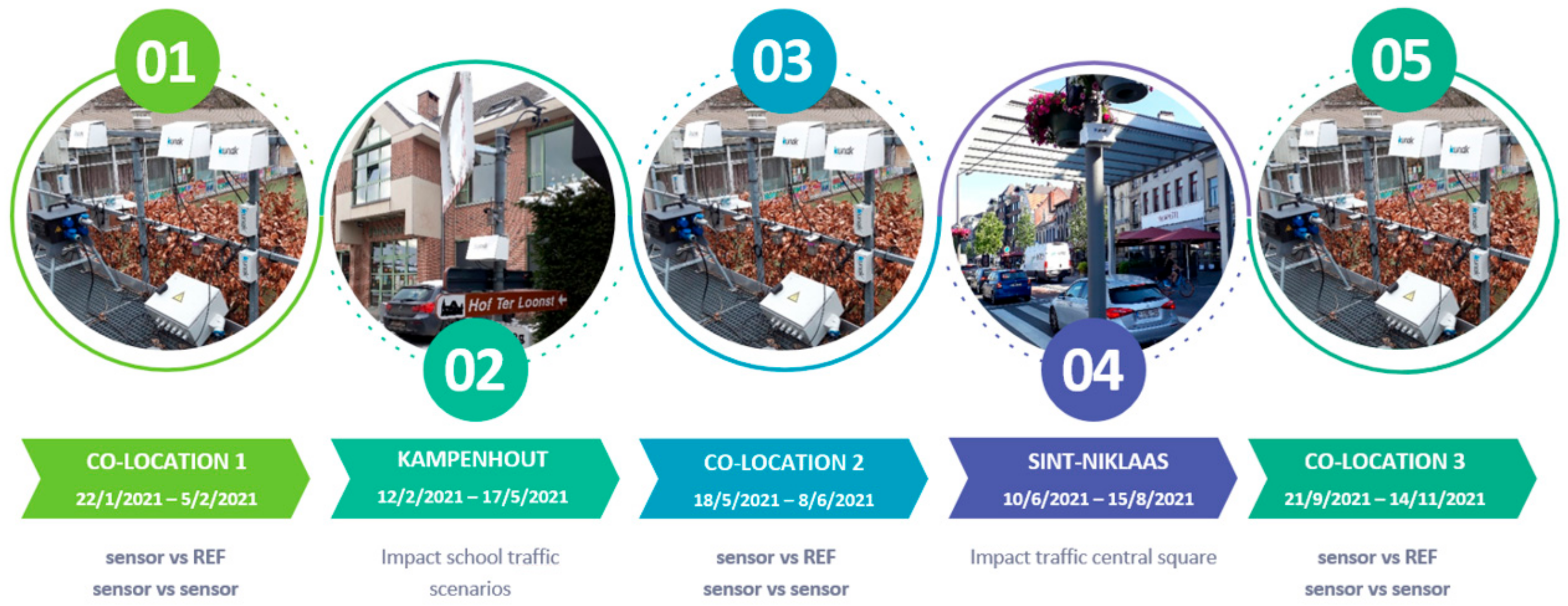

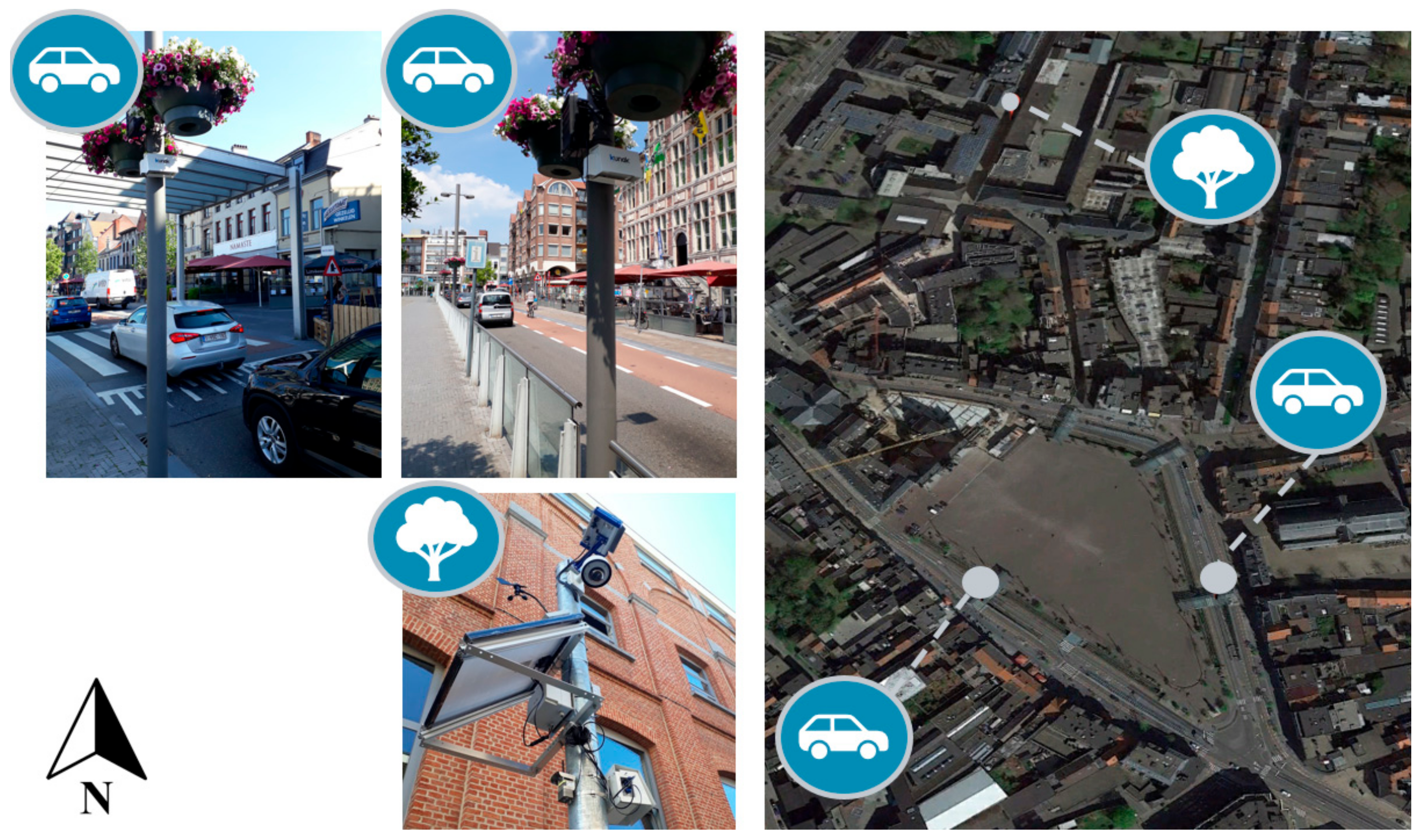
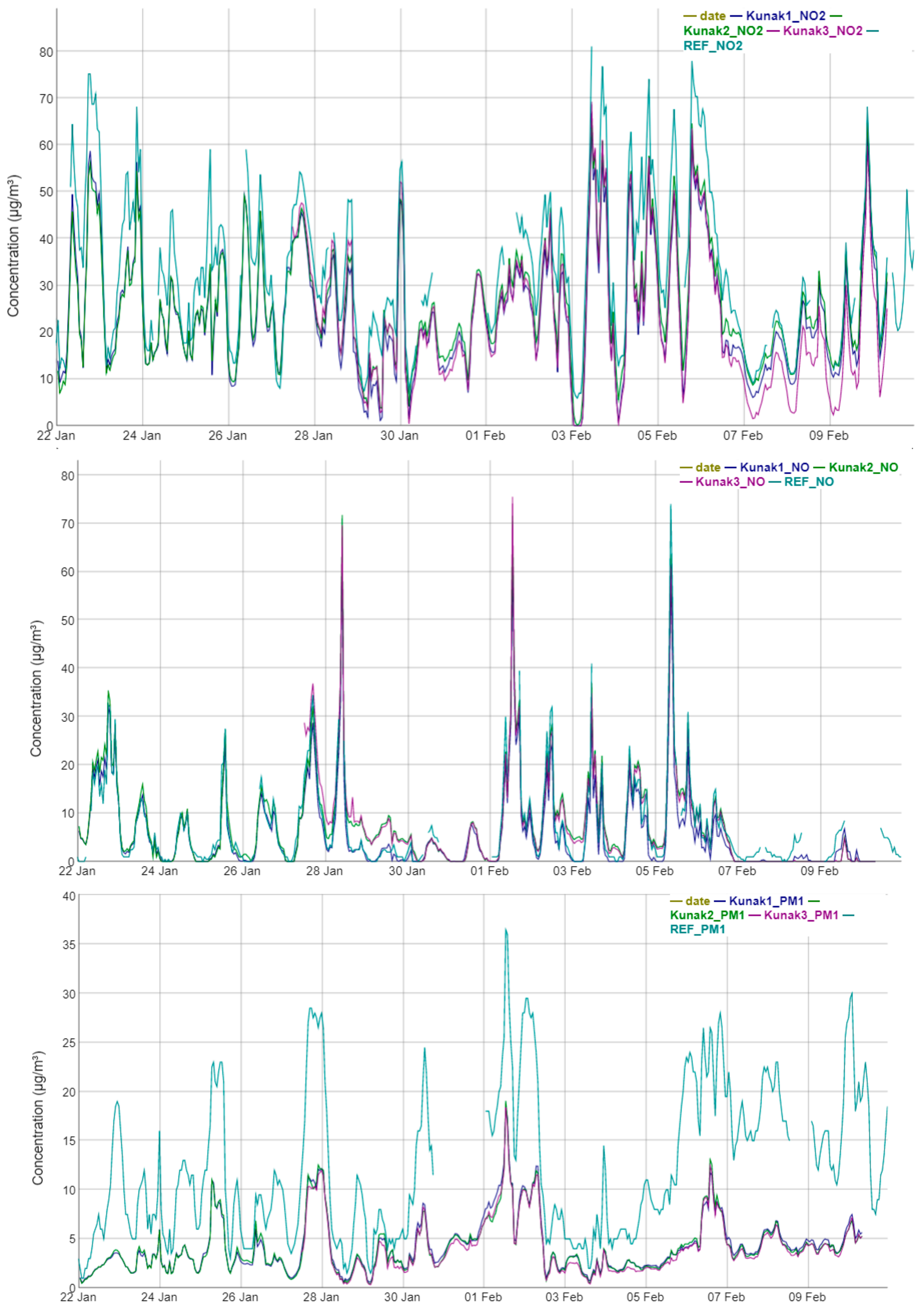
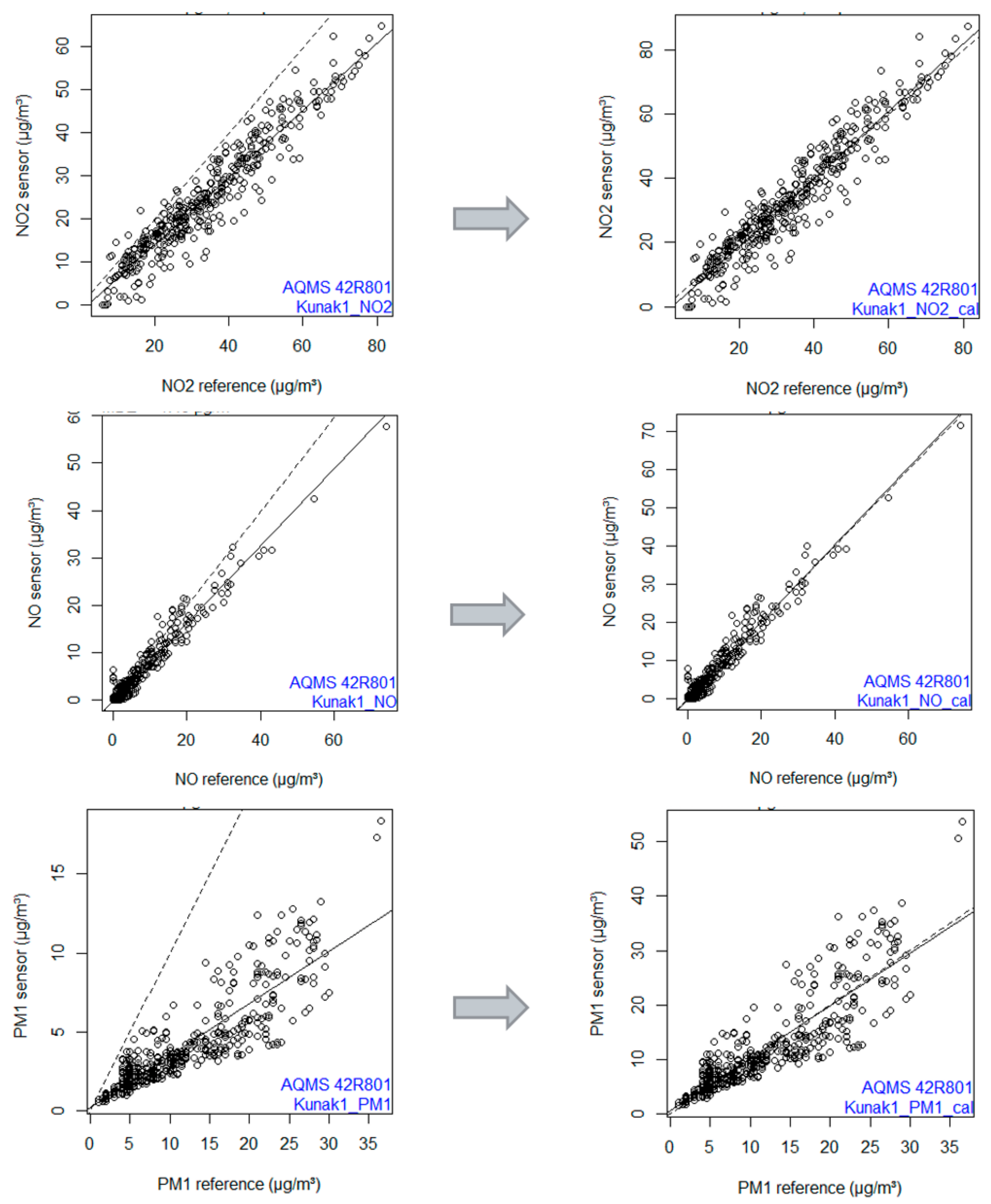
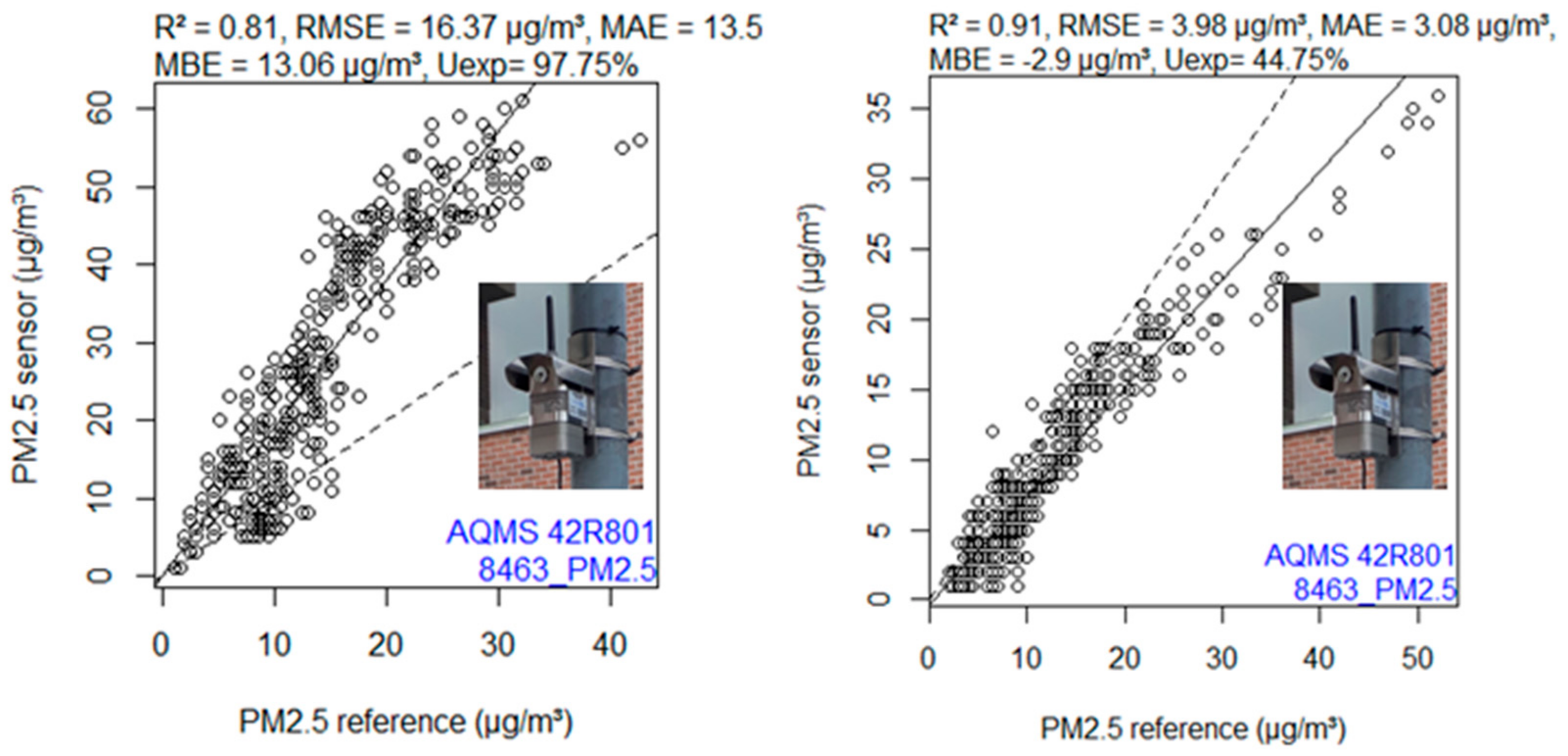
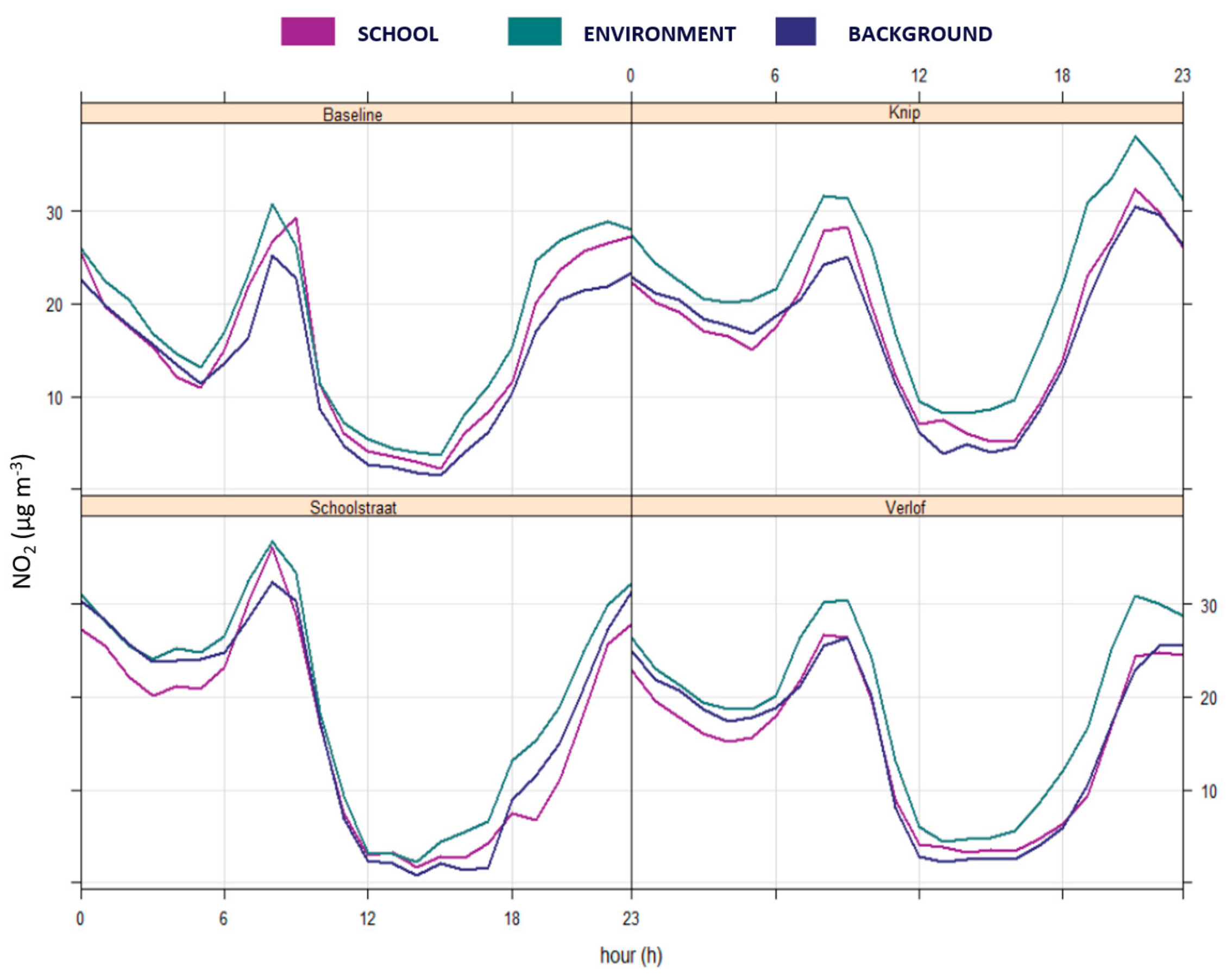
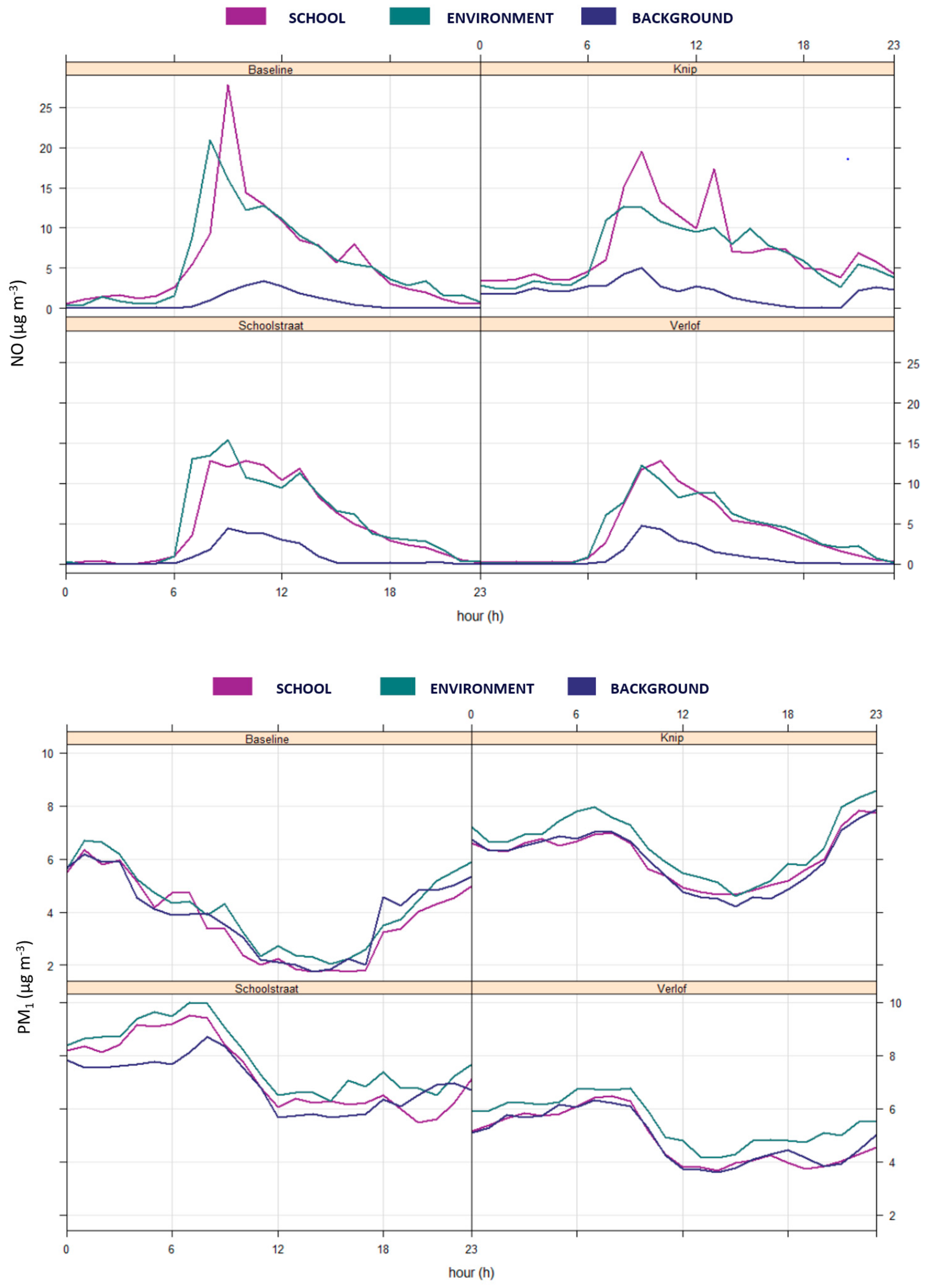
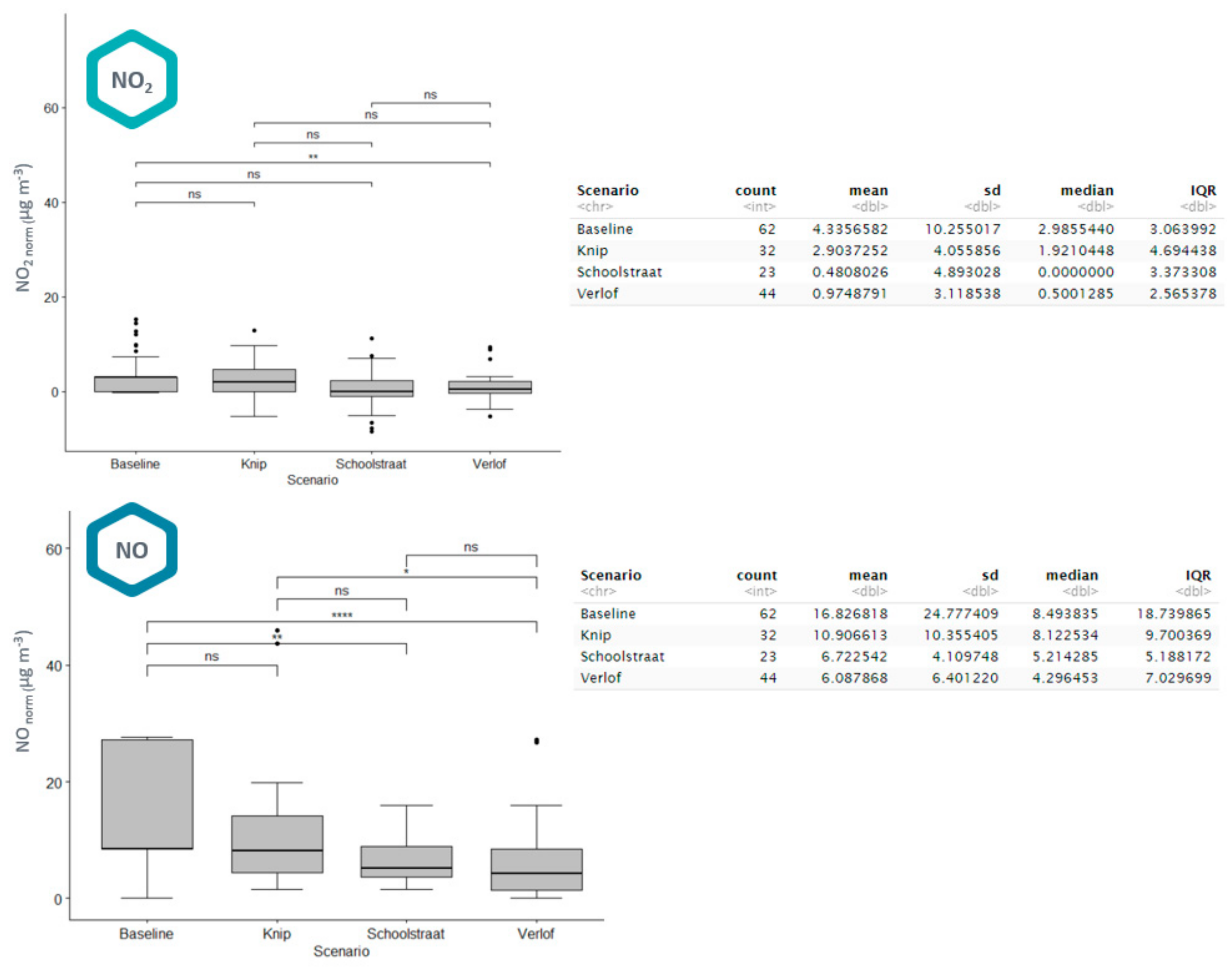
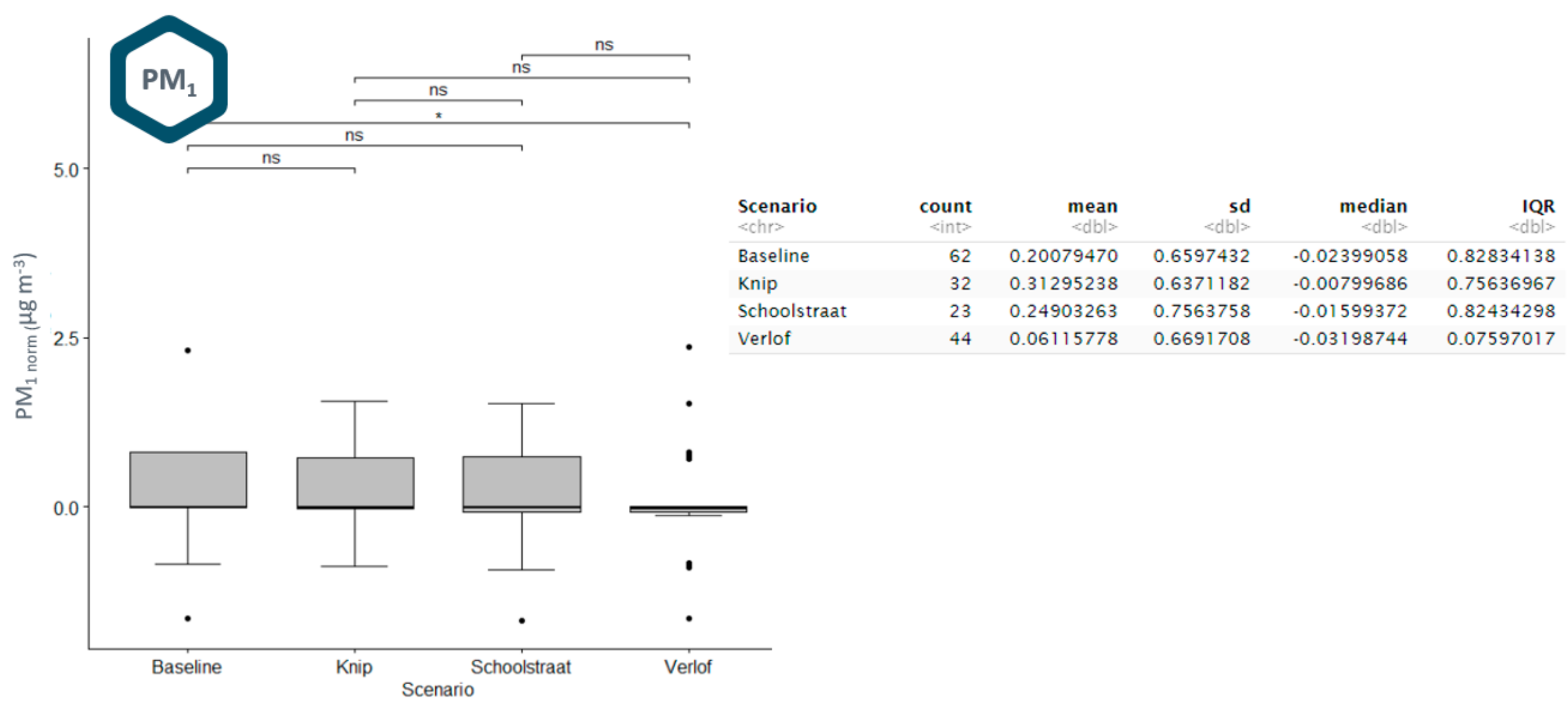
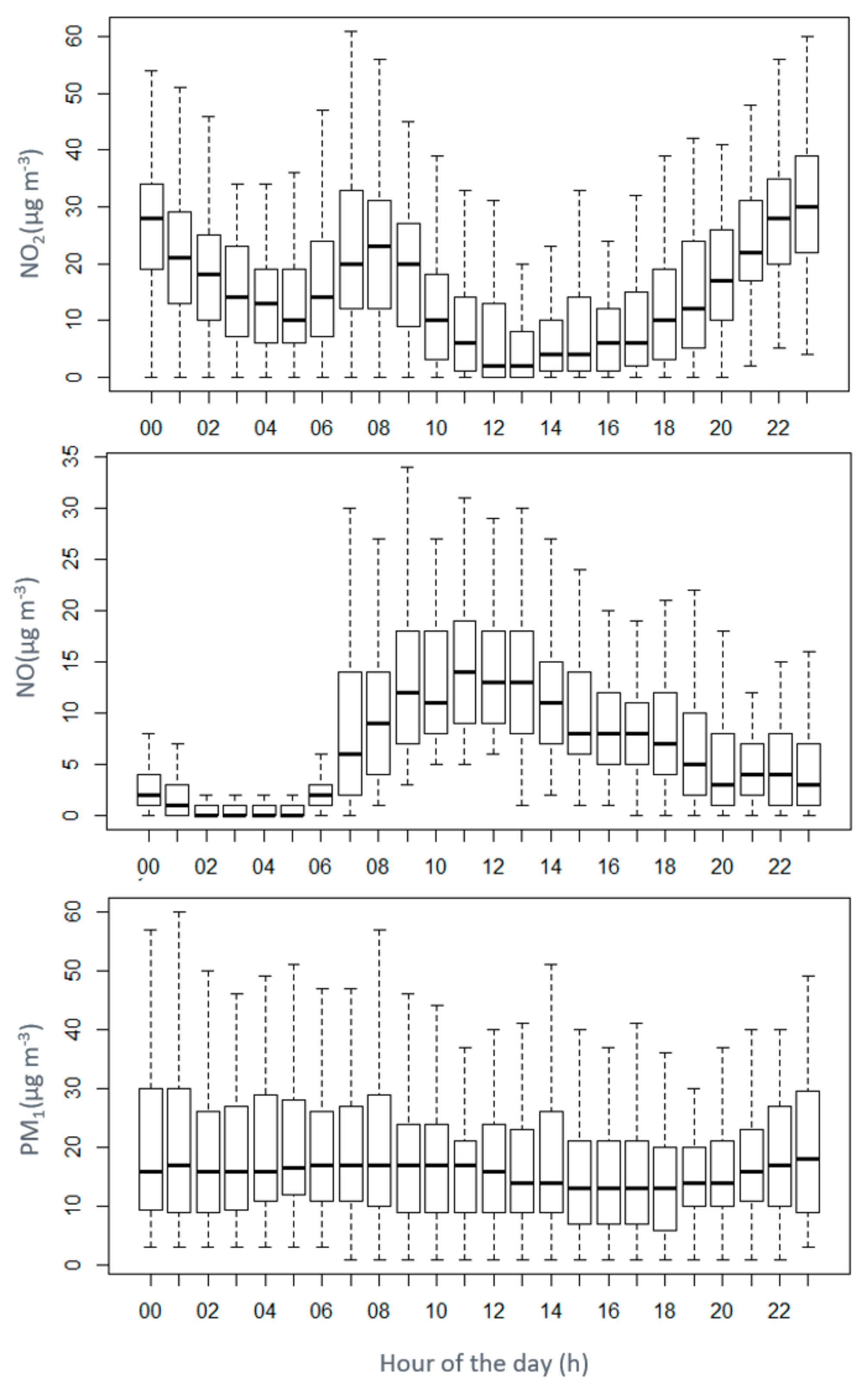
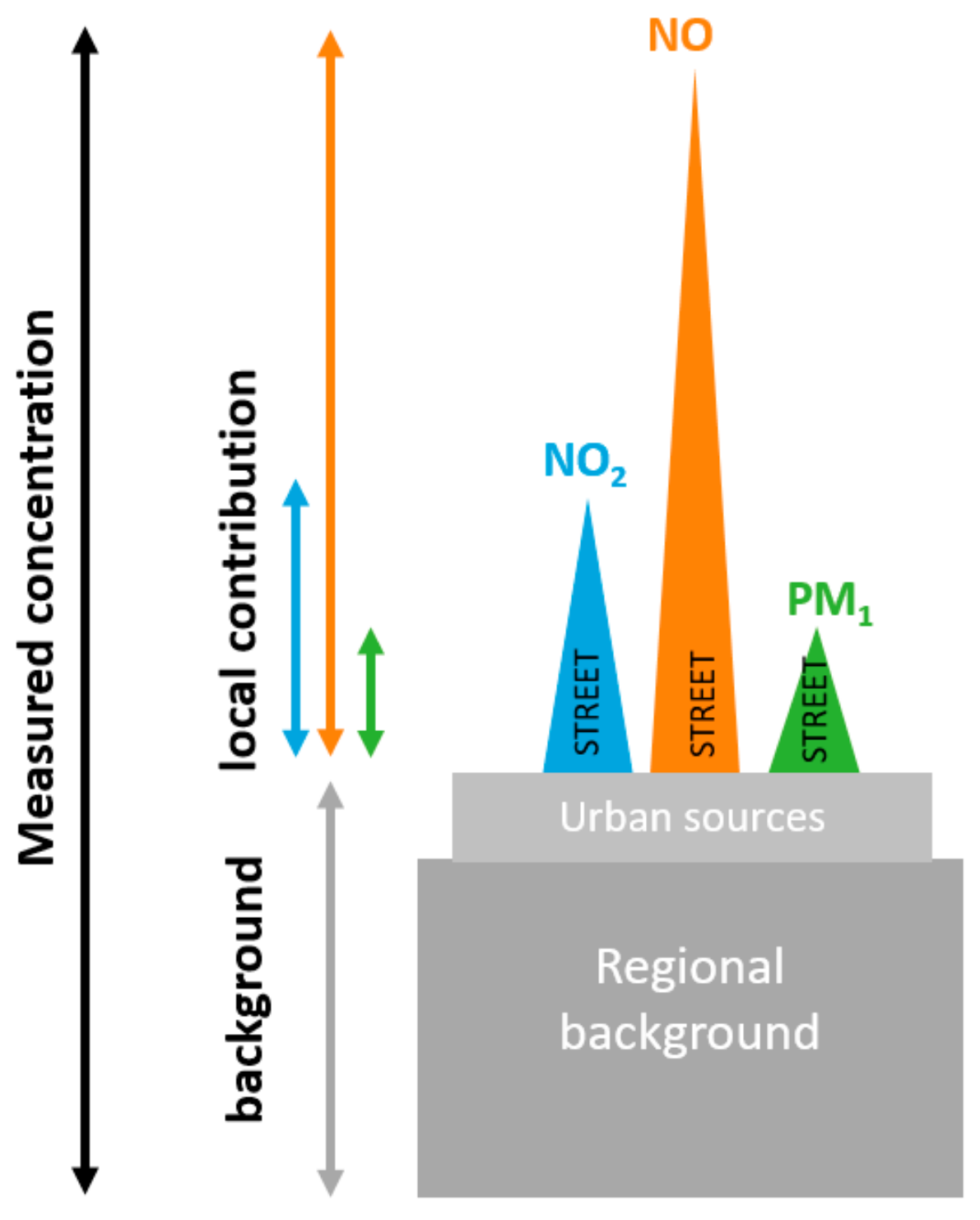

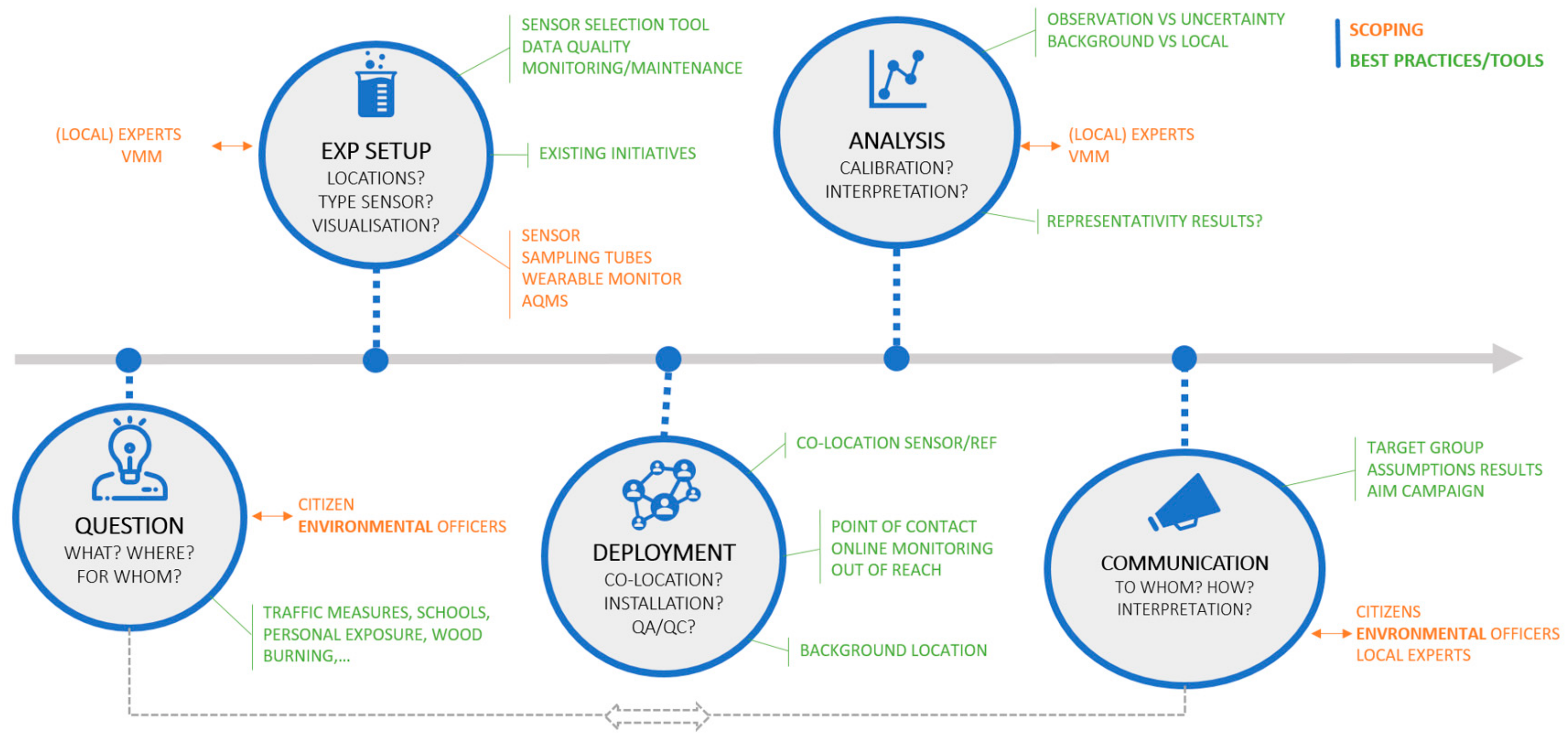
| Pollutants | NO2, PM1, PM2.5, PM10 |
| Time period | 3 months/pilot |
| Additional metrics | Temperature (°C), Relative humidity (%) |
| Number of sensors/locations | Minimum 3 (preferably 5) |
| Housing | Outdoor, weather resistant |
| Power | via solar panel |
| Communication | No WiFi available → via SIM/GPRS |
| Data quality | High quality needed: Good comparability (precision) between sensor boxes |
  | ||||||||||||
| NO2 | NO2_cal | NO2 | NO2_cal* | |||||||||
| Kunak_1 | Kunak_2 | Kunak_3 | Kunak_1 | Kunak_2 | Kunak_3 | Airly_8463 | Airly_12744 | Airly_12798 | Airly_8463 | Airly_12744 | Airly_12798 | |
| R2 | 0.92 | 0.94 | 0.95 | 0.92 | 0.94 | 0.95 | 0.00 | 0.69 | 0.02 | 0.84 | ||
| COR | 0.96 | 0.97 | 0.97 | 0.96 | 0.97 | 0.97 | NA | 0.83 | 0.14 | 0.92 | ||
| RMSE | 10.30 | 7.81 | 10.26 | 5.42 | 4.37 | 5.89 | 37.17 | 123.73 | 37.16 | 7.08 | ||
| MAE | 9.04 | 6.42 | 9.50 | 4.01 | 3.38 | 4.67 | 33.44 | 123.30 | 33.44 | 5.29 | ||
| MBE | −9.04 | −6.38 | −9.50 | −0.74 | 1.04 | −1.61 | −33.44 | 123.30 | −33.44 | 0.00 | ||
| Uexp | 42.95 | 33.00 | 39.66 | 26.20 | 25.11 | 26.77 | 110.07 | 364.54 | 110.07 | 36.82 | ||
| NO | NO_cal | |||||||||||
| Kunak_1 | Kunak_2 | Kunak_3 | Kunak_1 | Kunak_2 | Kunak_3 | |||||||
| R2 | 0.98 | 0.90 | 0.88 | 0.98 | 0.90 | 0.88 | ||||||
| COR | 0.99 | 0.95 | 0.94 | 0.99 | 0.95 | 0.94 | ||||||
| RMSE | 3.14 | 3.13 | 3.39 | 1.53 | 3.15 | 3.52 | ||||||
| MAE | 2.21 | 2.52 | 2.66 | 1.20 | 2.54 | 2.77 | ||||||
| MBE | −2.16 | 0.58 | 0.64 | −0.91 | 0.88 | 1.12 | ||||||
| Uexp | 27.76 | 15.71 | 15.71 | 8.87 | 12.27 | 12.27 | ||||||
| PM1 | PM1_cal | PM1 | PM1_cal | |||||||||
| Kunak_1 | Kunak_2 | Kunak_3 | Kunak_1 | Kunak_2 | Kunak_3 | Airly_8463 | Airly_12744 | Airly_12798 | Airly_8463 | Airly_12744 | Airly_12798 | |
| R2 | 0.73 | 0.73 | 0.75 | 0.73 | 0.73 | 0.75 | 0.85 | 0.87 | 0.82 | 0.85 | 0.87 | 0.82 |
| COR | 0.86 | 0.85 | 0.87 | 0.86 | 0.85 | 0.87 | 0.92 | 0.94 | 0.91 | 0.92 | 0.94 | 0.91 |
| RMSE | 10.67 | 10.83 | 11.01 | 4.75 | 4.87 | 4.83 | 4.85 | 3.14 | 5.31 | 3.01 | 2.75 | 3.35 |
| MAE | 9.05 | 9.23 | 9.47 | 3.59 | 3.71 | 3.65 | 3.91 | 2.50 | 3.95 | 2.33 | 2.16 | 2.30 |
| MBE | −9.05 | −9.23 | −9.47 | 0.24 | 0.03 | −0.17 | 3.30 | 1.39 | 3.35 | 0.49 | 0.44 | 0.40 |
| Uexp | NA | NA | NA | NA | NA | NA | NA | NA | NA | NA | NA | NA |
| PM2.5 | PM2.5_cal | PM2.5 | PM2.5_cal | |||||||||
| Kunak_1 | Kunak_2 | Kunak_3 | Kunak_1 | Kunak_2 | Kunak_3 | Airly_8463 | Airly_12744 | Airly_12798 | Airly_8463 | Airly_12744 | Airly_12798 | |
| R2 | 0.28 | 0.22 | 0.25 | 0.28 | 0.22 | 0.25 | 0.81 | 0.84 | 0.79 | 0.81 | 0.92 | 0.79 |
| COR | 0.53 | 0.47 | 0.50 | 0.53 | 0.47 | 0.50 | 0.90 | 0.92 | 0.89 | 0.90 | 0.96 | 0.89 |
| RMSE | 9.17 | 9.62 | 9.42 | 9.94 | 10.84 | 10.14 | 16.37 | 11.72 | 16.45 | 3.69 | 1.58 | 3.93 |
| MAE | 7.51 | 8.04 | 7.79 | 7.73 | 8.24 | 7.91 | 13.58 | 9.63 | 13.45 | 3.00 | 1.11 | 3.10 |
| MBE | −5.65 | −5.61 | −5.84 | 1.14 | 1.23 | 1.06 | 13.06 | 8.63 | 12.92 | −0.01 | 0.43 | −0.02 |
| Uexp | 68.31 | 70.53 | 69.85 | 91.33 | 93.94 | 84.63 | 97.75 | 71.08 | 96.67 | 18.67 | NA | 16.54 |
| PM10 | PM10_cal | PM10 | PM10_cal | |||||||||
| Kunak_1 | Kunak_2 | Kunak_3 | Kunak_1 | Kunak_2 | Kunak_3 | Airly_8463 | Airly_12744 | Airly_12798 | Airly_8463 | Airly_12744 | Airly_12798 | |
| R2 | 0.28 | 0.22 | 0.25 | 0.15 | 0.11 | 0.12 | 0.55 | 0.56 | 0.52 | 0.55 | 0.56 | 0.52 |
| COR | 0.53 | 0.47 | 0.50 | 0.38 | 0.33 | 0.34 | 0.74 | 0.75 | 0.72 | 0.74 | 0.75 | 0.72 |
| RMSE | 9.17 | 9.62 | 9.42 | 13.02 | 14.11 | 13.63 | 20.37 | 13.71 | 19.99 | 8.26 | 8.94 | 8.71 |
| MAE | 7.51 | 8.04 | 7.79 | 11.47 | 12.52 | 12.10 | 16.28 | 11.28 | 15.85 | 6.83 | 7.36 | 7.20 |
| MBE | −5.65 | −5.61 | −5.84 | −6.11 | −7.10 | −6.65 | 13.55 | 5.81 | 12.70 | −0.31 | −0.62 | −0.31 |
| Uexp | 68.31 | 70.53 | 69.85 | 39.91 | 47.14 | 43.75 | 47.00 | 47.00 | 47.00 | 24.24 | 24.24 | 24.24 |
| Kunak | Airly | |||||||||||
| NO2 | NO | PM1 | PM2.5 | PM10 | ||||||||
| RAW | CAL | RAW | CAL | RAW | CAL | RAW | CAL | RAW | CAL | |||
| CO-LOCATION 1 22 January 2021–10 February 2021 | COR | MIN | 0.978 | 0.978 | 0.963 | 0.963 | 0.964 | 0.964 | 0.986 | 0.986 | 0.984 | 0.984 |
| MAX | 0.997 | 0.997 | 0.983 | 0.983 | 0.984 | 0.984 | 0.989 | 0.989 | 0.987 | 0.987 | ||
| MAE | MIN | 2.597 | 2.067 | 0.795 | 0.758 | 1.336 | 0.850 | 1.424 | 0.950 | 2.029 | 1.860 | |
| MAX | 3.631 | 4.244 | 2.953 | 2.491 | 2.121 | 2.996 | 4.445 | 13.167 | 7.742 | 13.327 | ||
| NO2 | NO | PM1 | PM2.5 | PM10 | ||||||||
| RAW | CAL | RAW | CAL | RAW | CAL | RAW | CAL | RAW | CAL | |||
| CO-LOCATION 2 18 May 2021–8 June 2021 | COR | MIN | 0.986 | 0.986 | 0.837 | 0.837 | 0.837 | 0.837 | 0.921 | 0.921 | 0.920 | 0.920 |
| MAX | 0.993 | 0.993 | 0.978 | 0.978 | 0.915 | 0.915 | 0.959 | 0.959 | 0.959 | 0.959 | ||
| MAE | MIN | 1.931 | 2.227 | 0.741 | 0.597 | 0.741 | 1.479 | 1.004 | 1.456 | 1.387 | 2.639 | |
| MAX | 3.542 | 2.606 | 2.197 | 1.823 | 1.013 | 4.923 | 1.364 | 3.377 | 2.162 | 8.207 | ||
| NO2 | NO | PM1 * | PM2.5 * | PM10 * | ||||||||
| RAW | CAL | RAW | CAL | RAW | CAL | RAW | CAL | RAW | CAL | |||
| CO-LOCATION 3 21 September 2021–14 November 2021 | COR | MIN | 0.983 | 0.983 | 0.982 | 0.982 | 0.814 | 0.814 | 0.911 | 0.911 | 0.926 | 0.926 |
| MAX | 0.994 | 0.994 | 0.990 | 0.990 | ||||||||
| MAE | MIN | 4.753 | 2.365 | 0.629 | 0.859 | 1.452 | 2.242 | 1.690 | 1.924 | 2.767 | 3.152 | |
| MAX | 10.536 | 4.634 | 2.244 | 2.422 | ||||||||
| Background | Grote Markt 1 | Grote Markt 2 | |
|---|---|---|---|
| µg m−3 | µg m−3 | µg m−3 | |
| NO2 | 12.8 | 16.4 | 19.0 |
| NO | 2.2 | 7.6 | 10.2 |
| PM1 | 15.2 | 16.9 | 15.2 |
| PM2.5 | 17.8 | 19.1 | 17.8 |
| PM10 | 31.7 | 34.2 | 31.7 |
Publisher’s Note: MDPI stays neutral with regard to jurisdictional claims in published maps and institutional affiliations. |
© 2022 by the authors. Licensee MDPI, Basel, Switzerland. This article is an open access article distributed under the terms and conditions of the Creative Commons Attribution (CC BY) license (https://creativecommons.org/licenses/by/4.0/).
Share and Cite
Hofman, J.; Peters, J.; Stroobants, C.; Elst, E.; Baeyens, B.; Van Laer, J.; Spruyt, M.; Van Essche, W.; Delbare, E.; Roels, B.; et al. Air Quality Sensor Networks for Evidence-Based Policy Making: Best Practices for Actionable Insights. Atmosphere 2022, 13, 944. https://doi.org/10.3390/atmos13060944
Hofman J, Peters J, Stroobants C, Elst E, Baeyens B, Van Laer J, Spruyt M, Van Essche W, Delbare E, Roels B, et al. Air Quality Sensor Networks for Evidence-Based Policy Making: Best Practices for Actionable Insights. Atmosphere. 2022; 13(6):944. https://doi.org/10.3390/atmos13060944
Chicago/Turabian StyleHofman, Jelle, Jan Peters, Christophe Stroobants, Evelyne Elst, Bart Baeyens, Jo Van Laer, Maarten Spruyt, Wim Van Essche, Elke Delbare, Bart Roels, and et al. 2022. "Air Quality Sensor Networks for Evidence-Based Policy Making: Best Practices for Actionable Insights" Atmosphere 13, no. 6: 944. https://doi.org/10.3390/atmos13060944
APA StyleHofman, J., Peters, J., Stroobants, C., Elst, E., Baeyens, B., Van Laer, J., Spruyt, M., Van Essche, W., Delbare, E., Roels, B., Cochez, A., Gillijns, E., & Van Poppel, M. (2022). Air Quality Sensor Networks for Evidence-Based Policy Making: Best Practices for Actionable Insights. Atmosphere, 13(6), 944. https://doi.org/10.3390/atmos13060944







